SPECIAL REPORT…. Sad tales of Oyo’s Nomadic Schools where pupils risk lives to learn
The Nigeria government has often mouthed its commitment to quality and progressive education. In doing so, it instituted, among others, the nomadic education policy. Though well intentioned, the initiative has been fraught with nightmarish experience for many of its beneficiaries. In a bid to acquire formal education, kids risk life and bear unpleasant environments. The teachers are no better off, as they have to work under the most grueling conditions, with little or no tools.
JUSTICE NWAFOR captures the plight of pupils and teachers of nomadic schools in Oyo State.
Seated on the third row of the long wooden bench, Waheed Kaosarat, 12, listens attentively as her teacher reads out lessons on parts of speech of English language. Her face is shiny, flaunt with some glints of relief – an abridged form of happiness. The last lesson of the day is here and the day is about to end without any interruption.
She had prayed in the morning – like she does every weekday – for safety. First, from reptiles as she meanders her way through the bushy leeway to her school. Then from the same reptiles, but this time not while walking the bush paths but when seated in her mud classroom surrounded by lush green shrubs and trees.
The third – and by far the dearest to her – is safety from the clouds. “Let it not rain”, she would pray.
If the cloud gathers, and the winds howl, then school would be over for her and the other students for that day. They would have to run home. The tiny, weak, locally sourced sticks used to suspend the roof over the building could way up at the slightest test of the wind. And the aged mud walls already smacked by cracks could cave in at any provocation, unannounced.
“The situation in this school is pathetic. The structures are dilapidated and anytime the cloud is gathering, none of us can stay under this roof,” Kaosarat’s teacher and assistant head-teacher of Nomadic Primary school Oke-Kaa, Agbonle, Saki East, Oyo state, Adeagbo Oluranti told Ripples Nigeria.
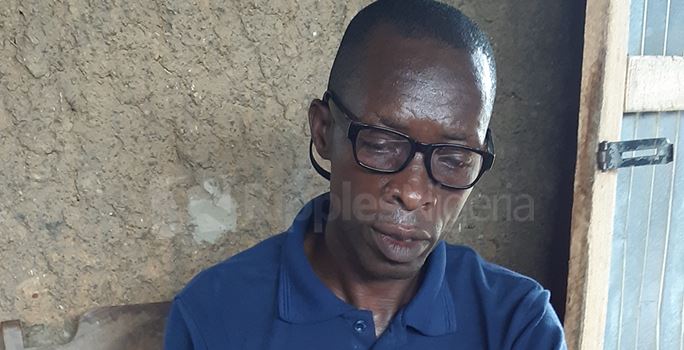
Mr Adeagbo
Back to her English class. While others squinted as this reporter entered the class, Kaosarat was busy taking down notes as the teacher faced the wide blackboard. She would, intermittently, raise her left palm to protect her face from the rays of the sun coming in from part of the blown-off walls of the classroom.
Soon, the class was over and there was an intersection of relief and happiness. She picks up her schoolbag with a few books inside, adjusts her hijab to ensure it is properly in place, and makes for the door. But the smiles soon gave way for shyness as this reporter approached her.
Threatened dreams
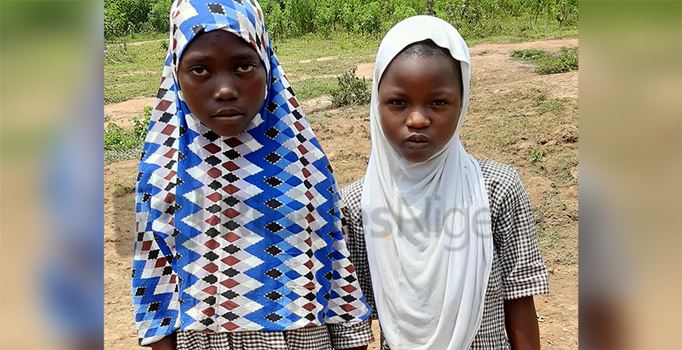
Kaosarat and Haliyat
“I want to be a doctor”, she muttered in Yoruba, when asked about the career path she wants to take. This reporter enquired why she could not express herself in English, but her teacher intervened. “There is hardly one who can speak English”, he said.
Soon, the prying eyes of Kaosarat’s younger sister, Waheed Haliyat, 8, caught us. She looked smart and her mouth sharper than her elder sister’s, but still could not say a word to this reporter in English. Kaosarat is in primary 6 while Haliyat is in primary 2.
Unlike her elder sister, she wants to be a teacher. But Kaosarat and her sister’s dreams, as well as those of about 100 pupils in this school are threatened. They are threatened by lack of learning facilities, dilapidated infrastructure and life-threatening classrooms.
Not just dreams, but the life which holds fragments of the dreams is not spared too. The surrounding bush exposes the pupils and teachers to imminent attack from reptiles. And the school building – a mud of three classes, now two classes – can hardly pass for a goat pen.
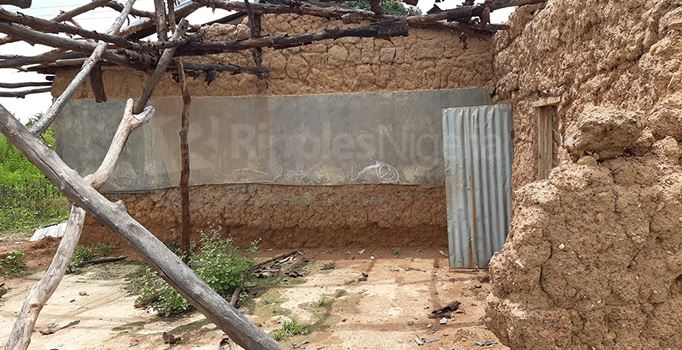
The classroom destroyed by wind
The roof, then walls, of one of the initial three classes were blown-off by what the teacher called “a terrible wind”. But the remaining two need no terrible wind but a slight push to turn them to rubbles. The floors are muddy and dirty, and still broken in its current state. No power supply. No computers. No water. No convenience.
When asked how they cope when nature calls, Haliyat’s teacher, Fato
Ever since one of the classrooms was blown-off, the remaining two have served as the only classrooms. Pupils in pre-basic (Kindergarten) are lumped in the same class with primaries one and two. While pupils of primaries three to six are lumped in the remaining classroom.
Explaining how herculean it is to teach more than one class in a room, Elizabeth told Ripples Nigeria they divide the blackboard into three or four, as the case may be, and pupils sit according to their classes. So, when it is the turn of a particular class to learn, they pay attention.
“We are combining them together because of space. There is no space (and) there are not enough teachers. Some times when I give one class work to do, I would be calling the other class and be marking their works one after the other” she explained.
The physical environment of schools, Michael Lakin and Lavinia Gasperini wrote in their book, ‘Education for rural development: towards new policy responses’, “determines, to a large extent, the quality of schooling.”
The other important physical factors, they further explained, include the “climatic suitability of the building; the adequacy and repair of the classrooms and other facilities; ventilation and lighting; the existence and condition of a playground, a garden and toilets for the children (separate for boys and girls); and the supply of electricity and drinking water.”
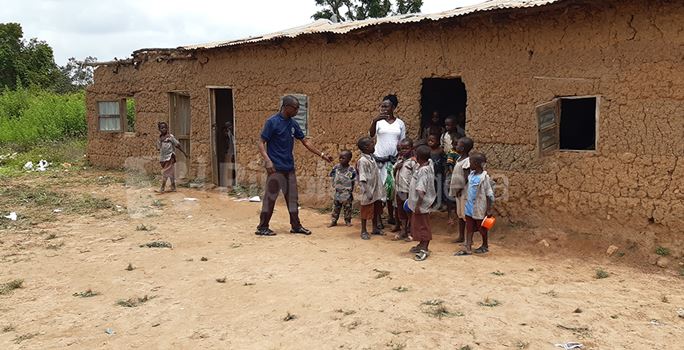
Nomadic Primary school Oke-Kaa
As this reporter walks into the school, a signpost with the inscription, ‘Nomadic primary school Oke-kaa, Agbonle’ is
Apart from paying the three teachers in the school, head-teacher and assistant inclusive, there is no other evidence of government presence in the school. However, this reporter met less than fifty pupils in school, as at the time of visit in late September – more than a week after resumption for the new academic session.
Amidst the neglect, there is a commission in charge of nomadic education in Nigeria – National Commission for Nomadic Education (NCNE). Established in 1989 by decree 41 (now Cap 243 LFN 1990) of the then General Ibrahim Babangida administration. Its primary goal is to provide education to nomadic pastoralist, migrant fisherfolks and migrant farmers. The commission estimates the populations of these three groups to be around 9.4 million with children of school age numbering 3.3 million. However, it admits, there is a dearth of accurate data on the population in recent times.
Also, on its website, it stated that it has been implementing the goals of the federal ministry of education. They include: Providing and sustaining unfettered access to education for the total development of the individual and promoting Information and Communication Technology Capability at all levels; through focusing on its mandate.
Nomadic Primary School, Oke-Maria: Picture of neglect
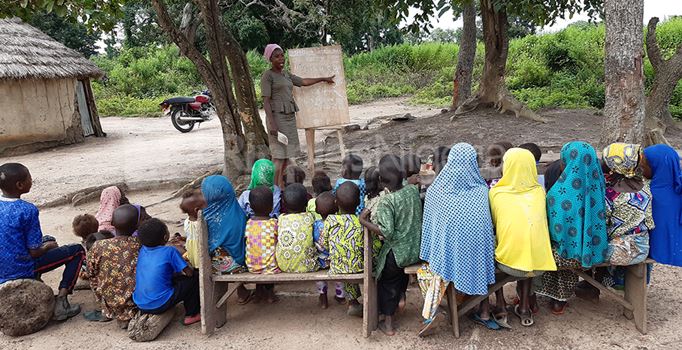
Pupils of Nomadic primary School, Oke-Maria
Driving through the water-clogged bush paths to Oke-Maria, reveals a community of Bororo – not Fulani – settlers. Tucked away in amazing green vegetation, the community is seated behind and almost totally dwarfed by the beautifully crafted Oke-Iyanla mountain.
The journey to this community was not as debilitating as that of Oke-Kaa. While it took this reporter about two hours on a bike, from sight of a tarred road, to Oke-kaa, that of Oke-maria was about an hour.
First sight in the community is a dwarf, roundish, thatch-roofed mud house with different sizes of grid cracks. The kind of building that reminds you of Nigeria’s pre-independence rural era.
Few steps forward, more look-alike houses come into sight. Children are seen playing bare-footed, half naked – some totally naked. A middle-aged woman, neatly dressed – the kind of outfit that makes you feel like an alien in an environment – is seen ringing a bell. She orders the children to get their bags and get set for school. And the time was 9:25 am.
This reporter would later learn she is one of the teachers at Nomadic Primary school, Oke-Maria, Atisbo LGA.
Now at the school. Pupils are beginning to trickle in – in twos. Others come in groups of fours, still barefooted, without books, pencils or even school uniform. Gradually, a substantial number gathers – under a tree.
At this point, this reporter was expecting the pupils to be moved to the school building. But no. Here is the school – under a tree, adjacent another. Shrubs are close-by with a handful of mud houses giving it some sense of liveliness.
“This is the school”, Oketoyin Toyin explains to Ripples Nigeria.
Toyin and her colleague, Adedokun Oladoyin – the only teachers in the school – are setting up the classroom. Three wooden benches already decimated by age, are brought together. Two are placed adjacent to each other and the other at the back. Then rotten wood and stones are picked to form makeshift seats on which the pupils would seat to learn. The seats are carefully set to escape from rays of the day’s rising sun.
Then what is meant to be a blackboard – which is actually grey – is placed before the seats. The class is set. And it is time to teach and learn. As the class went on, some of the pupils slipped off their seats. They were not tired of learning, but tired perching instead of sitting due to inadequate seats. The stronger ones actually endured.
There are three classes in this school – Kindergaten, Primaries one and two – with enrolled pupils of about 90. And the classes are just the shades the trees provide.
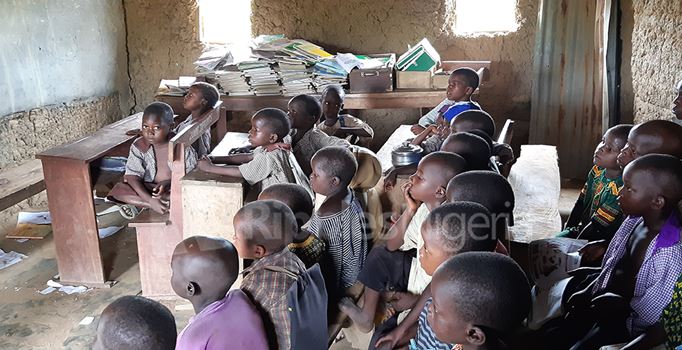
Kindergarten and primaries 1 and 2 are lumped together
“How we do it is, when we want to teach a particular class, we just tell them to look at the board or sit down, call them one after the other and show them.”, Toyin said.
Experts agree that the quality and standard of schools in rural areas contribute immensely to human capital index in any given society. And teachers are a major aspect of the very important complex.
“Teachers are a key input, but the rural teacher is generally poorly trained, supervised, supported and remunerated. Many teachers must cope with ill-equipped classrooms overcrowded with children of several ages. Difficult working conditions …tend to sap the morale of even dedicated teachers. Another serious problem in many rural communities is the frequent tardiness or absence of teachers, whether due to ill health or to other employment to make ends meet”, Lakin and Gasperini wro
Adamu to the rescue
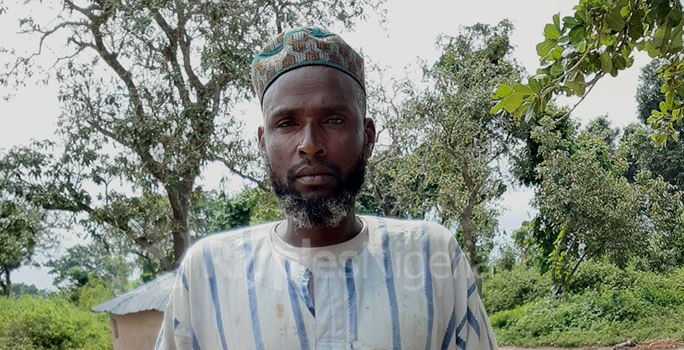
Mr Adamu
What could the situation had been if Mr Adamu Usman – a parent of one of the pupils – had not provided two of the three benches used in the school. He also made available to the school the only blackboard it can boast of.
When Ripples Nigeria asked Mr Adamu why he made the provisions to his son’s school, he said, in Yoruba, he is driven by the desire to see his son and other children get education which he could not get. This, he further explained, would help lift him from poverty. There are many like him in the community. Even though they have not provided anything to the school, they want their children to be educated.
As this reporter watched the class continue, a kid was heard crying in the bushy path that led to the school. A few minutes later, a man emerged carrying a boy of about eight years on his shoulder. He dropped the boy at the feet of Toyin and walked away. The now helpless pupil struggled to run back to the father, but was restrained by the teacher. He would later be identified by the teachers as one of the parents who wants all his children to go to school. Another of Adamu’s kind.
While there are some parents in Oke-Maria who want their children to get educated, there are many who would prefer they sit at home, farm or herd cattle.
“There are about 90 enrolled pupils in the school but we have more people at home. Some parents say they don’t have money for books and uniform; so, they won’t allow them to come to school”, Toyin said.
We beg parents to allow their children come to school
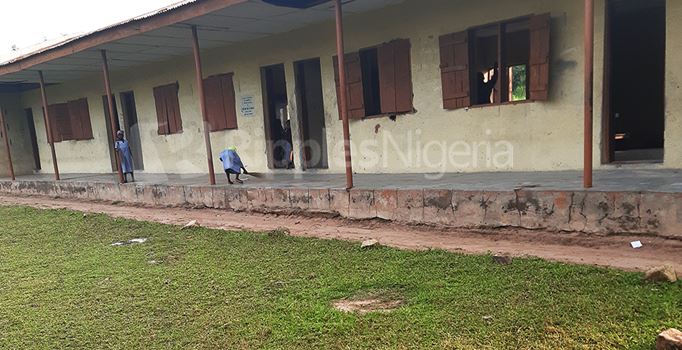
Nomadic primary school Sambo
Before this reporter left for Oke-Maria, he was at Nomadic Primary School, Sambo, Tede, in Atisbo LGA. A walk into the school premises reveals a block of three empty classrooms. Situated along the Tede-Saki road, the school is the parent school of the one in Oke-Maria.
“The school was established in 1998. The number of pupils here was 50 but gradually the number reduced. Now we have about 19 pupils enrolled in the school … but the problem we are facing is that the schoolboard has ignored the other annex (Oke-Maria). The main school has no pupils but the other one that has pupils has been neglected”, Ajayi F.O, the head-teacher of the School told Ripples Nigeria.
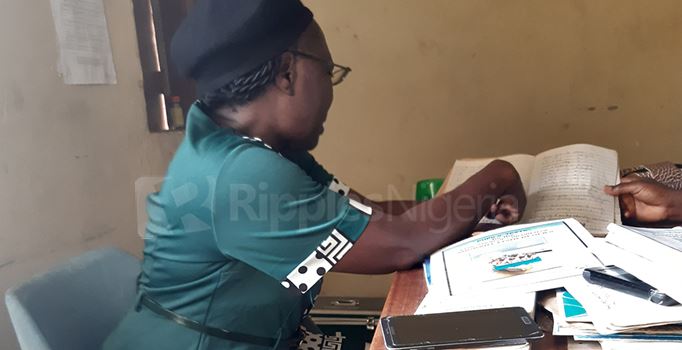
Mrs. Ajayi
On the challenge teachers face to get the pupils to come to school, she said, “we have tried a lot and we are fed up. They don’t usually allow their people to come to school because they don’t value education at all. Sometimes we beg the parents to allow their children to come to school, but some will not allow them.”
When this reporter asked Taiwo about provision of facilities in the school, she threw back the question, while still flipping through pages of an old notebook on her desk; “you are here, can you see any?”
The school lacks basic facilities needed for learning. No power supply. No water. No computers. No convenience. Just three empty classrooms with a handful of desks.
As the head teacher walked out of her office – which can only boast of an aged table and two chairs with lumps of old textbooks – with this reporter, five pupils walked into the school with neither books nor pencils, barefooted without school uniforms. Then she explained: “one of the reasons the parents don’t allow their children to school is, according to them, lack of money”.
“Some of these (school uniforms) you see them (pupils) putting on were bought for them by the teachers. Their parents will tell you they don’t have money to buy uniforms, books and even pencils for them. So, we help them in our own little ways.”
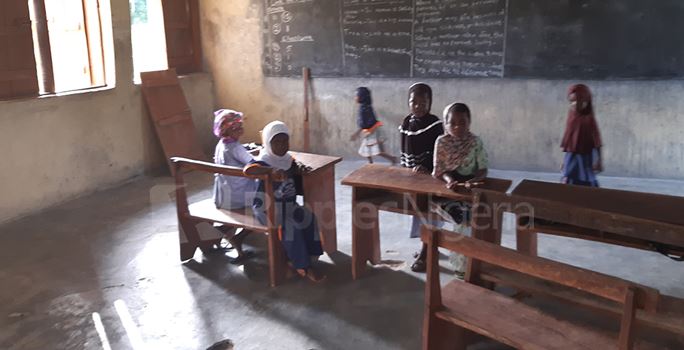
Empty classroom at Nomadic primary school, Sambo
One denominator among the schools this reporter visited is lack of facilities. From Oke-Kaa to Oke-Maria and Sambo, the story is basically the same. There are no adequate facilities to aid learning.
Primary schools, UNICEF says, should provide significant personal and social environment in the lives of the pupils. And the environment should be physically safe, emotionally secure and psychologically enabling.
When these environments are not adequately provided for, the capacity of pupils can be greatly undermined, and in worse cases, permanently destroyed. This, in no small measure, would lead to a weak educational foundation which would greatly impact the society at large, and ripple down to poor human capital index.
We lack fund – NCNE
When this reporter visited the southwest zonal office of the commission at the federal secretariat, Ikolaba, Ibadan – after about two weeks of no response to email enquiries sent to the national headquarters – he met a brisk looking man. Clad in grey coloured trouser and a brown shirt covered by an apron of a popular Pentecostal church in Nigeria, he was ushered into a wide office with well-arranged files on the desk.
A man in his 50s was sleeping on the black, aged couch with legs ajar. He jumped to his feet, and this reporter was offered a seat.
After introducing the essence of the interview, the man who ushered me into the office introduced himself as the southwest zonal director of the commission. But refused to reveal his name, then began.
“I thank you because you have visited them. In nomadic schools, that is what we are facing. When we are talking about sponsorship, we want the government to step in. You can go and check how much funding we get. Funding is something the government needs to step up. We need money to do these things. One thing I want to assure you is, if there is funding, we will do marvellously well.”
“Sometimes we collaborate and train the teachers. In fact, there was supposed to be a training that was supposed to hold in Oyo state two years ago, unfortunately there was no funding. Sometimes we look for foreign intervention, but they are not forthcoming again.”
When reminded of the sections of the NCNE Act which makes provision for funding and mandates the commission to provide facilities in nomadic schools, he retorted, “and if the funds are not released, what do you do? Will you kill somebody?
He then paused and reminded this reporter that he was not supposed to speak to him on the matter and referred him to Oyo state Universal Basic Education Board (Oyo-SUBEB). On a second thought, he continued.
“We don’t provide, we motivate the state. We don’t own schools.We liaise with the various states (and) ensure that these hard to reach people are taken care of. Let them have access to education. The states have failed too.”
Oyo SUBEB Blames Communities
As this reporter left the NCNE office, he went to the SUBEB secretariat. The offices at the secretariat have no inscription on the doorposts to indicate the department they belong to. After asking around for some minutes, he was directed to one of two offices located at the top floor of an aging storey building.
Now at the office. He was ushered into a small-sized room with a man seated behind what looks like a newly acquired desk. His eyes still gazed at the fourteen-inches-sized television set at the top left corner of the office, he offered this reporter a seat.
Then the conversation started. “This department is school services, and nomadic education is one of the units here, and the unit is under my cover. I am a deputy director. My director just stepped out”, he said. When asked his name, he said, Bolaji. But this reporter pressed further for his surname and he reluctantly said, “Bolaji Hassan”.
Scenarios at the schools visited were played out to him and he started: “There has been misplacement of priority. If priority is given to it, not only by the government but by the community. The community too can do something about it because their children are learning there. That’s why we involve the SBMC, School Based Management Committee. They are the ones that educate the communities on the importance of providing necessary facilities for the learners there. Ours is to make our contributions and ensure that education progresses.”
Bolaji was then reminded that the only mud of classrooms in Oke-Kaa was provided by the community, and the government has not done any other thing to improve on the situation.
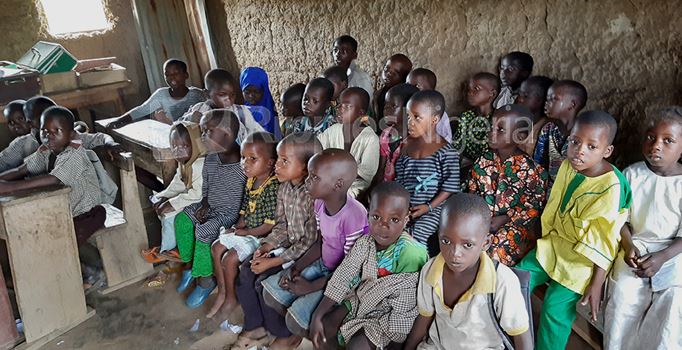
Pupils of KG, Primaries 1 and 2 at Oke-Kaa
“I am a civil servant and I can’t run down my state or parastatal”, he resumed.
“We are in the 2019 budget and we have taken notes of a lot of things. These things are parts of what we have budgeted. Come 2020, most of these schools will be visited to ascertain the conditions there. After that, we will know how to allocate whatever amount given to us. Our officers on ground are giving us reports and we are planning to carry out a follow up visit to the schools.”
This visit, Oladoyin – the teacher at Oke-Maria – has seen a lot of already, and does not make sense to her anymore: “they visit us and take notes. They will go back and nothing will happen. The last time they came was before the (2019) elections and nothing has still happened”.
Further efforts to speak with Oyo SUBEB Chairman, Nureni Adeniran was fruitless as he refused to respond to calls or SMS sent to his mobile number.
While pupils in relatively better schools prepare for the future and the challenges of the 21st century, those in hard to reach areas suffer neglect and are uncertain of what the future holds. Perhaps they are certain of just one thing – going through the vicious circle of poverty they are born into.



